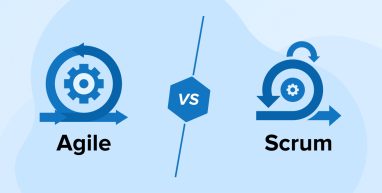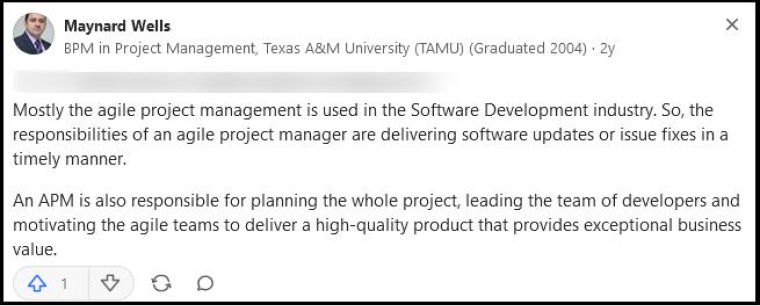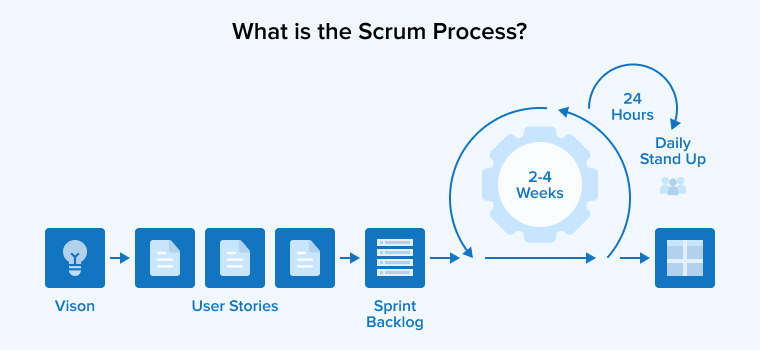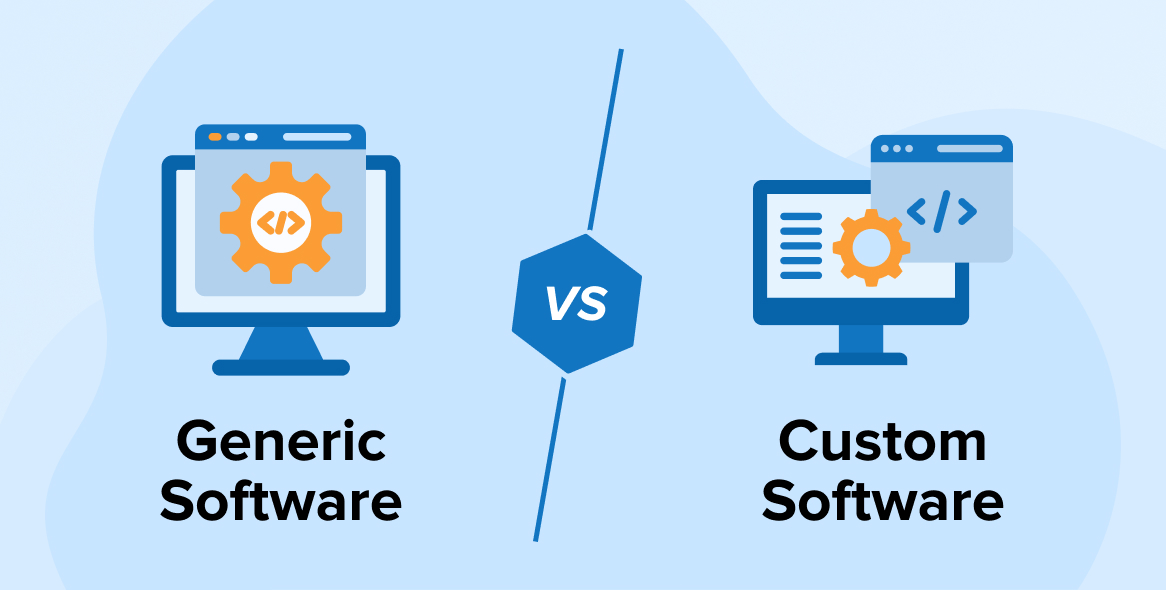
Those who are new to project management may find themselves confused between these two methods that are available to manage the entire process. These methodologies enable the project managers to carry out their responsibilities in an efficient manner.
For the managers, it is vital to identify the risks that are related to the development process and ensure that the plan they came up with can eliminate or limit those risks. And for this, the best option is to choose the best project management framework available in the market.
Before going through Agile vs Scrum processes, let us first understand why project management is essential and then understand Agile vs Scrum methodologies in detail with their pros and cons.
1. Why Project Management is Important?
A proper understanding of project management, which wasn’t prevalent a decade ago, is now crucial. In 2013, around 46% of organizations didn’t see its value but now the scenario is totally different as organizations have started taking initiatives employing project management. The reason behind this is that the majority of the high-level executives in any organization think that now project management is a very important approach.
Project management is an approach that has a sharp focus on the unique circumstances and requirements of the client’s project that general management might overlook. Proper project management eliminates the likelihood of project failure. As per a survey around US$122 million is wasted because of the poor management project. This is one of the main reasons why various custom software development companies take project management philosophy into consideration. It is not only effective but also efficient.
2. What is Agile Project Management?
Agile is known as one of the most popularly used project management methodologies available in the market. When it came into existence, it started as a software-focused project management approach. And now it has evolved into a development methodology that enables organizations to rapid iterations and break down large projects into smaller chunks.

Agile software development divides the project into smaller segments, known as sprints. Different Agile teams working on the same project are then assigned these sprints to enhance efficiency and speed. Besides this, organizations also use Agile as it enables integration of the development team with stakeholders and customers which enables them to have on-time input from everyone at the end of each sprint. This progressive approach enables the software developers to ensure that the product they created has met the consumer’s expectations.
2.1 What is the Process of Agile?
When it comes to Agile project management there are a few things that are a huge part of it and they are sprints, iterative backlog management, additional sprints, and iteration. Each sprint in Agile comes with a specific process which is as follows:

- The very first step is where the product owner organizes the backlog of the product which means that a list is prepared of all the tasks that need to be carried out in a project. This list includes tasks that need to be carried out in a single sprint and the information saved in a project management program.
- And as soon as the planning of creating a sprint starts, the entire project development team engages in the planning process in order to select the best-suited tasks to focus on for the next two weeks of the timeframe.
- During the time when the sprint is in process, the team that focuses on agile methodologies regularly discusses action items and impediments.
- Basically, they follow a proper software development process in the sprint and by considering that sprint, the team members get together for a sprint retrospective so that they can analyze everything and see to it what went perfectly fine and what needs improvements.
2.2 Advantages of the Agile Methodology
There are many reasons behind the popularity of the agile process when comparing with other traditional project management approaches, some of them are:
- Emphasis on Customer Collaboration: The Agile Manifesto comes with 12 different agile principles and 4 values that every agile software development company must practice as it enables them to understand the importance of customer collaboration. Besides this, agile enables the customers and the cross-functional teams to work together to achieve the desired goals.
- Faster to Market: Agile comes with a primary goal of delivering the product as soon as possible to the client and helping them roll it out to the end-users.
- Good with Documentation: When developers were using the traditional waterfall methodology they required comprehensive documentation with long-term project planning but with agile philosophy coming into the picture, the right way of writing documentation can come into existence in order to start a project. This documentation comes in the form of a whiteboard or flipchart.
- Easy Adaptation to Changing Requirements: With agile, when any developer is working on a project, they can easily break it down into different development cycles known as iterations. And after iterative development, the next step is to get the customer’s reviews to take the project to the next level. Once the feedback is in, the developers can work accordingly to develop new features or remove them.
2.3 Disadvantages of Agile Methodology
The agile methodology also comes with some side effects in spite of being so popular and they are:
- Designing and documenting a project sometimes lack the intensity required in Agile.
- This process isn’t useful for projects with smaller sizes.
- To work with Agile’s methodology, every development team needs an expert who can make critical decisions.
- If the project manager lacks in giving proper instructions about the project, it can easily go off track.
- Agile methodology is very costly compared to other software development methods.
3. What is Scrum Project Management?
Scrum project management is another modern approach for developing projects with a unique method. It enables the developers to separate the project development strategy into smaller sections. Each smaller part in the Scrum framework, known as a sprint, typically takes around 2-4 weeks to complete. Scrum is very closely related to the Agile development approach.

When it comes to scrum project management, the development process is led by the project manager and the product owner. The Scrum master and other cross-functional team members are also an integral part of this process. Here the scrum master ensures that the scrum team follows all the rules of this method and the scrum product owner is responsible to enhance the value of the product. In Scrum, the team essentially selects and completes sprints according to the planning to ensure the timely development of the product.
3.1 What is the Scrum Process?
Just like Agile, Scrum is also designed to help software development teams in developing the product efficiently, effectively, and quickly. Scrum is the best option for various cross-functional teams as it comes with three separate Scrum phases and keeps every software developer on track to complete a Scrum. The Scrum master, the product owner, the project manager, and other team members handle software development projects working on Scrum. Here, the role of the scrum master is very important as he leads the entire project. And this role comes with the following responsibilities in different phases:

- Phase 1 – Here, the Scrum sprints are initiated and conducted over a period of 2 weeks. During the planning phase of the sprint, the Scrum Master analyzes the tasks of the team members and the team’s product backlog. Subsequently, the Master decides which sprint needs to be worked on.
- Phase 2 – In this stage, the Scrum Master conducts daily Scrum standups, during which teams engage in 15-minute discussions every day to talk about the work and analyze the project’s performance to date.
- Phase 3 – Here, the Scrum Master ensures the organization of the sprint retrospective meeting. In this meeting, the Master assesses the completed work, ensures any unfinished tasks are queued for future action, and readies the team for the next sprint.
3.2 Advantages of Scrum Methodology
Scrum methodology comes with various different benefits and some of them are:
- High-quality Product: Scrum enables the software developers to constantly check in with customers to let them give feedback which can be utilized to create products as per the client’s requirements. With Scrum, quick changes in the product development direction are possible in order to deliver high-quality projects.
- Working Product Availability: The Scrum method provides an incremental delivery system, meaning the product is released when it meets the client’s requirements. This not only saves significant marketing time but also enhances the potential for increased revenue. This shows that Scrum offers an iterative and incremental approach which helps in getting the working product quickly.
- User Satisfaction: When it comes to Scrum, actual user feedback is really important in order to bring evolution to the project as it enables the developers to deliver high-quality products to the customer.
3.3 Disadvantages of Scrum Methodology
Scrum also comes with a few disadvantages and they are:
Any Scrum without working product at the end of a sprint is a failed Scrum.
Jeff Sutherland.
- Higher Commitment Stakeholders: For the success of a project with Scrum, the active involvement and complete commitment of stakeholders are necessary. They have to attend all the meetings and events, if not attended, there might be some problems that may arise.
- No Clear Definition: At the beginning of the project, the goal of the product development is not clear in Scrum which makes it difficult for the Scrum master to organize the project.
4. Agile vs Scrum Comparison
Here we will go through the points that help us in comparing both Agile vs Scrum –
| Parameters | Agile | Scrum |
|---|---|---|
| Definition | Agile development is a methodology that follows the development and incremental approach to create a product. | Scrum is a method that follows an iterative and incremental approach. |
| Flexibility | Agile is a flexible method as it reacts quickly to the changes made in the project. | In Agile vs Scrum comparison, Scrum is more flexible, so it is highly accepted in the market. |
| Client Involvement | Regular feedback from clients is required in this process. | After every sprint, the client is involved to check the progress and give feedback. |
| Communication Required | With Agile, open communication between the cross-functional teams and customers is required. | In Scrum, daily meetings are held between team members, the scrum master, and the product owner. |
| Management | The project lead manages the development process. | The entire team works together and manages the project to resolve the issues. |
| Used For | Agile is used for organizations that have experienced software development teams. | Scrum is the method that can be used when the project’s requirements keep on changing. |
5. Conclusion
As seen in this Agile vs Scrum blog, Agile is a popular project management tool that enables product managers to create a system where the customers are involved and their feedback is taken in to make the project a success. While on the other hand, Scrum is known as a process that takes Agile practices into implementation. Due to the significant similarity between these concepts, people often find themselves confused about which one to employ in their product management process. This is why acquiring proper knowledge about both and understanding the subtle differences these processes entail is crucial, as discussed in this article.






Nice article to understand these frameworks for better understanding of project management. The way the writer outlined the process of these both methods make it easier for newcomers to understand their structure and functionalities.